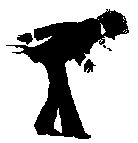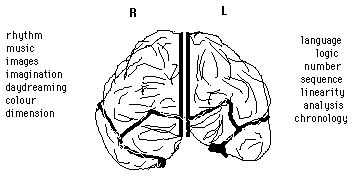
the brain
'... I must confess I thought myself too much neglected, not without some degree of contempt. For neither Prince nor people appeared to be curious in any part of knowledge, except ....'
There is still a huge amount to learn about the brain. But we have come a long way since the days of Alcmaeon of Croton in 500 BC. He was the first to state that the brain was the seat of the intellect - before then it was thought the heart ruled the body. Alcmaeon - he was a pupil of Pythagoras the famous Greek geometry sage - may have got this right, but he had a few other ideas which haven't stood the test of time. Alcmaeon had a strange theory that the only way in which goats could breathe was through their ears!
The largest human brain on record is the 2012 gram one of the Russian writer Turgenev. This can be compared to the brain of the sperm whale at around 9000 grams.
Our brains are in fact smaller than a sparrow's in comparison to body size. The brain of a cat is two and a half times that of a dog. You can make of that what you like, according to whether you prefer cats or dogs! However, some clever people have been found to have small brains.
In the past 50 years we have come to know more about the brain than in all years before: finally the human brain is studying itself > this means growth.
It has for instance become common knowledge that the left and right hemisphere of the brain dominantly deal with different intellectual functions.

The left brain primarily handles: logic, language, numbers, sequence, analysis, chronology, and so on, while the right brain deals with rhythm, colour, imagination, intuition, feeling, day dreaming, spatial relationships, and so on.
Research has shown that the left brain is not the so-called intellectual side, nor is the right brain the so-called intuitive, emotional side. Both sides need to be used in conjunction for both academic and creative success.
The Right brain controls the left side of the body and the Left brain controls the right side. The one cannot very well control both sides: there has to be balance even physically. This is called cooperative opposition. If only one side is used: e.g. the Left, everything "is logical, rational", the wrong 'formula' is used. Another fantastic feature is: the brain is self-creating, the more it is used the more it can do, however, to make the most of it this should always be done in conjunction of the two brain-halves.
To understand and describe it the brain has been conceived as a control system similar to a complex computer or telephone exchange - and that there are enough lines in it to give a phone link up to every person on earth - transmitting information through electronic impulses; as a kind of television system with the capacity to reassemble coherent patterns and images from millions of separate pieces of data; as a sophisticated library or memory bank for data storage and retrieval; as a complex system of chemical reactions that transmit messages and initiate actions; as a mysterious black box linking stimuli and behaviour; as a linguistic system operating through a neural code which translates information into thoughts, ideas and actions through chemical and electrical changes, rather like the code represented in an alphabet can be converted into prose through words and sentences. It is none of these: it is what it is and instead of worrying about what it is, it is better to use it.
On a visit to Japan Mrs. Thatcher was shown a computer which her Japanese hosts said could translate from English into Japanese and back again. The computer failed miserably.
What this showed yet again was the limitation of computers. And how the human brain - which has to program them in the first place - is so superior in comparison.
There are plenty of funny facts about the brain. An American scientist has worked out that the brain power of a beetle is greater than that of an IBM computer. And all this from something that is 85 percent water. Size though - like so many things in life - is not that important.
Just like computers (which it is not!) the main point is to 'program' the brain properly. The potential is there, what it comes down to is what do I do with it.
Computers have been used by doctors to make the diagnosis in a puzzling case of illness. Some of the results are quite impressive, and computers show where they can score over brains. A computer can hold large numbers of facts and figures without forgetting any, and work on these much faster than the human brain.
However, someone still has to program it. The doctor and the patient must put all the necessary information in. If nobody tells the computer that the patient with a fever from the Isle of Wight has just come back from the jungle of Borneo - then the computer may not consider malaria. (A doctor interviewing that patient may remark that the patient's sun tan hadn't come from the south coast of England.)
Actually children learn most by looking at grown ups. 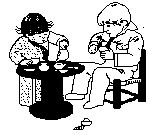
They are great imitators and for their behaviour depend very much on the comments of their parents. Still they seem to do well, learning a language (and 2 if needed) is not a mean feat! Yet this free learning ends at about the age of four. Then the "scientific method" starts: school. Children are told to do something and if they cannot perform satisfactorily, they are told they are not doing well. This fact is corroborated when the child compares its work with that of others and thus is convinced it is no good at..... (whatever it was doing). The children are told to do it by themselves and not to cheat (look at the other children's work). So authority in the person of the teacher has established the fact that it is no good at ...... So many grown-ups have this idea that they are no good at: mathematics, drawing, music or .......(please fill in whatever you think you're not good in) .
Creativity means leaving this "I can't" pattern and going outside it. The pattern means "I can't, so I won't." Our brain is perfect, but we are not always using it perfectly. When we have the formula that we are no good at ......, the brain will perform worse and worse in this area; we are bound to see the evidence because of our failures. And failures are bad: our culture rewards success and punishes failure. So we are trained in the schools to avoid failure, yet to make mistakes, i.e. to fail, is necessary to learn, it provides feedback for our brains.The 6 months' old child has no such fear and when given a toy it will have most interest in the wrapping: it will tear at the paper (tensile strength test), put it into its mouth (biochemical laboratory), spit it out (quality control reject= unfit for food), bang it on the table (try out the possibility for producing sound), etc. . The child is using its complete brain and is not hindered by any stereotyping. It is not afraid to make mistakes; no, it tries and the trial provides feedback. This feedback is fed into the brain and stored, and thus we see few children who continue to eat newspapers because they find them nice and nourishing. Therefore it is essential for most of us to reprogram our brains i.e. use it according to a different formula. The new, original formula will make complete use of the brain and both sides will add.
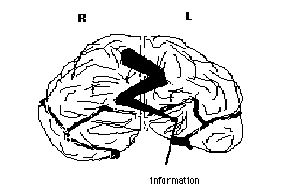
There seems to be one gigantic conspiracy to make children only see what we want them to see. Luckily a product like Lego does the opposite. You buy for your children a special kit, you build it up and ...... in no time they have combined it with other kits and make something entirely new.
When the brain is used properly data perceived will be passed from one side to the other and become more extensive; to multiply or subtract imagery can help very much; for making calculations we tend to look at the ceiling: we then project the image of numbers in order to facilitate calculation. When learning by heart children often tend to move their bodies rhythmically: rhythm combined with linearity. Fairy tales are methods/systems to remember! By "dressing up" the facts into a story we can recall them very easily and we make use of the axiom: the more you know, the easier it is to know more. This is based on the principle of redundancy, you remember more when you have stored more! You will have more references to connect up with the fantastic miracle in between your ears. The main interest should be effectiveness. Education often seems to pay more attention to efficiency. And my brain is completely adjusted to me, I don't have to use one particular language to activate it, anything will do from smell to sound, from picture to word.
It does not matter how I program it as long I know how I labelled the information.
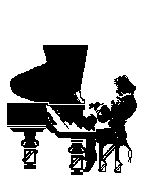
Many performers remember whole pieces of music by connecting the notes to stories. Stories they tell themselves while playing in concert! And who cares as long as the music sounds good, the applause will follow.
